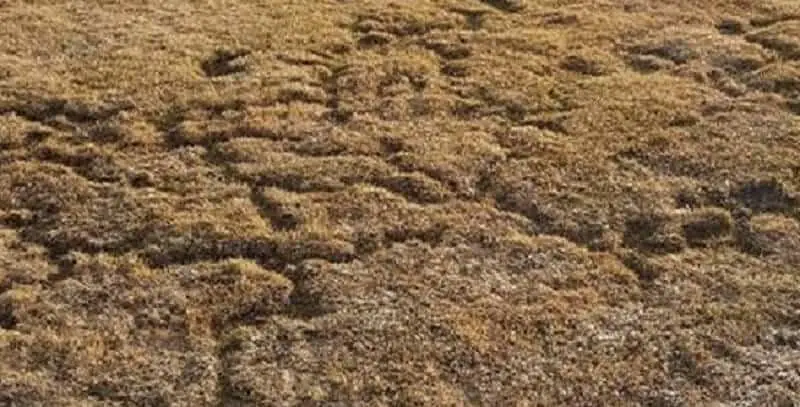Every spring when the snow starts to melt, my lawn shows extensive signs of voles. This year, I had enough and decided to take steps to stop the problem.
Voles wreak havoc on yards and gardens. They eat roots, seeds, and other organic materials. They kill plants and trees.
And, voles are hard to contain because they spend a lot of their time underground.
Many of the articles found online discuss the same vole removal actions. It’s suggested that homeowners spread poison, set traps, or use home remedies.
But, these solutions create other problems.
If you have kids, then setting traps can make your yard a landmine. If you live where hawks and owls are, then poison can kill birds of prey. And, home remedies require a lot of time and consistent reapplied to be successful.
So, what’s the best method to get rid of voles?
The answer depends on your situation, time, and finances. It also depends on how much land you have and how many voles you have.
This article will cover the many aspects of how to get rid of voles and various methods that are best for each situation.
How To Get Rid Of Voles
If you have a vole problem in your yard or garden, you must first figure out whether it is voles or moles. Once you have confirmed you have voles, you can then take steps to get rid of the pest.
You will need to consider the best methods for your family. This article will go over the pros and cons of each method of vole protection so that you can choose the best method, based on your available time, patience, kids, pets, and other factors.
Even as you work to get rid of the vole problem, there are preventative steps that you can take to protect your lawn, flowers, trees, and garden from voles.
Many people prefer to reduce or eliminate the vole population. This can be done through natural means such as a mouser or it can be done by poison or traps. We will also discuss the pros and cons of these methods.
Voles are very prolific and because of their sheer numbers, they adapt quickly. This means that some methods may be effective initially, but cease to be effective later. You may need to use a combination of multiple methods to be completely effective against voles.
- Identify the problem: voles or moles
- Understand Vole Habits and Diets
- Analyze The Best Solutions For Your Yard and Family
- Protect Lawn, Trees, Flowers, and Gardens From Voles
- Use Predators TO Reduce Vole Population
- Use The Right Vole Poison and Traps
- Home Remedies Used Against Voles
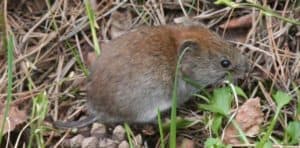
1. Identify If You Have Voles Or Moles In Your Yard
It is critical to understand whether your yard problems are caused by voles or moles. Although there are similarities, the impact to your yard is vastly different.
But, it’s easy to confuse a vole and mole.
Both animals dig underground burrows. Both seen to cause damage to your yard. And, their natural habitats overlap in some areas.
Yet, the impact on your yard is different. And, if you want to get rid of them or keep them out of your yard, it’s important that you know which underground pest you have or your bait won’t be effective.
Moles dig deeper underground networks. They dig hundreds of yards a day. Moles also dig higher tunnels that can be viewed above the ground. One of the best ways to know if the tunnels are caused by voles or moles is to look for little mounds of dirt. These mounds will look like little volcanoes and are traps that moles make to trap their food.
Voles don’t leave mounds when they dig.
If you see the culprit, then you can identify it visually. Moles have large feet for digging. They also appear to have no eyes or ears. Voles have small ears and visible eyes with a short tail. Voles look like a mouse and are often called field mice.
You can also tell the difference between a mole and a vole with the damage done to your yard. Voles generally do more damage to trees, bushes, grass, garden, and other vegetation.
The primary diet of voles is roots and vegetation.
Moles dig underground, but their main diet is carnivorous. They love to eat slugs, earthworms and other bugs.
Voles generally come above the ground regularly. But, moles are rarely seen above the soil.
Another difference is in their sheer numbers. While moles are generally loners and only 2-3 moles will occupy an acre on average, voles reproduce in large quantities.
Voles will start mating early spring and continue reproduction until the fall. Female pups are sexually mature after only 13 days so voles reproduce very quickly.
Vole:
- Creates tunnels and runways just under the surface of the ground
- Eats mainly vegetation
- Mouse-like appearance
- Damages plants, trees, and gardens
- Comes above the ground to eat
- Tunnels are never more than 3 inches wide
- Very prolific. If there is one, there is usually an entire colony.
Mole:
- Creates deeper tunnels as well as visible tunnels just under the ground
- Leaves mounds of dirt behind
- Eats mainly bugs, slugs, animal remains, and other carnivorous foods
- Looks like they don’t have eyes or ears
- Large feet for digging
- Rarely seen above ground
- Good for the soil
- Live alone: 2-4 moles per acre
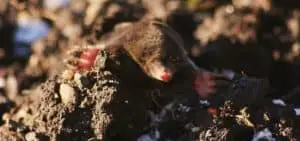
Moles are very different from voles. They have no eyes or ears
Photo Credit: Flickr Andy Muir
Voles can do a lot of damage to a lawn, especially during the winter when vegetation is sparse. But, moles don’t do as much damage. They may dig through tree roots while tunneling, but they don’t devour vegetation.
Understand Vole Habits And Diet
If you need to get rid of voles, it’s important to understand the difference in their diet so you can trap them. Voles eat primarily vegetation.
Peanut Butter is the best bait for voles. It has a pungent smell that will attract voles to the area. It also works well for mouse traps.
If you have moles, they won’t be attracted to Peanut Butter.
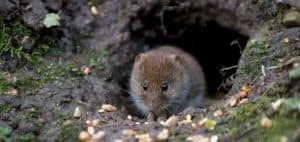
Analyze The Best Solutions For Your Yard And Family
There are a lot of solutions out there. Each solution has its own challenges and benefits. You should analyze your own values and resources available.
Questions to consider include:
- Do you want to repel voles away from a specific area or get rid of them as much as possible?
- How do you feel about killing voles?
- How much time do you have to invest in solving the vole problem?
- What are you willing to spend on getting rid of voles?
- Do you want to try lower cost home remedies that require more time, but cost less, or do you want more effective or more permanent solutions that cost more money?
All of these are important factors in deciding which solution you should utilize for vole control.
Protect Flowers and Gardens From Voles
Flowers, trees, and gardens are susceptible to vole consumption. Voles love roots and vegetation.
Trees, bushes and flowers are especially vulnerable during the winter when vegetation is rarer and voles are hungry.
Even if voles continue to be a nuisance, you can take steps to protect specific crops and plants.

Photo Credit: Flickr Ryan Hodnet
Bury Hardware Cloth or Tree Guards To Protect Against Voles
Hardware cloth can be buried 12 inches deep in the ground. The hardware cloth should extend up 6 inches above the ground.
Voles don’t climb well so 6 inches high will keep them from the bark of trees. Tree bark is a favorite snack of voles.
You can also use Iron tree guards. They are usually 4-6 inches wide and are buried underground to keep voles away from tree roots and bark. Iron barriers are effective in keeping voles away from an area.
They are also used for flower beds and gardens as an effective deterrent.
Tree guards can be used above ground to protect tree bark from voles.
Cost: Usually a one-time cost. This solution is usually more expensive than other solutions but provides permanent protection against voles in specific areas of the yard.
Time Spent: Guards take time to install. They must be buried entirely around the area. This is often labor intensive.
Effectiveness: Hardware cloth, guards, and barriers have a very high rate of effectiveness in keeping voles out of a specific area if they are installed correctly. They must be installed around an entire area. If a gap is left open, then voles can enter the area and become trapped. This will cause them to eat almost entirely the vegetation that you tried to protect.
Permanence: This is a permanent solution.
Plant Flowers That Repel Voles
If you have a vole problem with eating flower bulbs, then consider replacing your flowers with those that repel voles.
Certain bulbs have a strong odor and are offensive to voles.
The most effective method is to plant entirely flowers that repel voles. But, you can experiment with planting offensive flowers around and near other flowers to protect them.
Flowers that repel voles:
- Snowdrops (Galanthus nivalis)
- Winter aconite (Eranthis hyemalis)
- Glory of the Snow (Chionodoxa)
- Wood Squill (Scilla siberica)
- Daffodils (Narcissi)
- Guinea Hen Flower Lilies (Fritillaria)
- Alliums (A. Moly and A. Schubertii)
- Camissa

Photo Credit: Flickr Rhonda Flemming Hayes
Another trick is to bury a little gravel around your flowers when you plant them. The gravel discourages vole activity when they come across it.
Cost: Moderate cost. Bulbs are usually $3-5 per few bulbs. Most of the flowers named can often be found at the dollar store and in grocery stores. The actual cost will depend on the extent of your flower garden.
Time Spent: Little to moderate time to plant the bulbs. Bulbs must only be planted once and then can be left alone thereafter.
Effectiveness: These flowers are very effective in keeping voles and other rodents away. They will be more effective if dispersed evenly throughout your flower gardens or around your trees. I give it a moderate rating because it will greatly depend on how many you use, which allows for a lot of room for error.
Permanence: Bulb flowers are usually permanent unless you kill them or dig them up. They are perennials so they come back every year and, once established, can often go years with neglect without dying.
Use Predators To Reduce Vole Population
Another option that many homeowners love is to introduce predators that can kill and reduce the vole population. Because voles come above ground semi-regularly, it gives predators a chance to catch them.
There are several types of predators that you can either adopt as pets or encourage their presence in the area.
Use Cats To Reduce Vole Populations
are generally good mousers. In my area, voles are extremely prominent. The houses on my street are surrounded by fields, so there is a never-ending supply of voles that come into the yard.
One of my neighbors has solved her vole problem with a good mouser cat. The cat lives outside and gets fed once a day. The rest of the time, it goes after voles. It has completely reduced her vole problem to the point that her lawn and other shrubbery is not damaged at all with tunnels.
Cat breeds that are known to be good mousers are:
- American Shorthair: These cats have been used as mousers for centuries. They were first used on ships and boats as mousers. They love to roam around and will keep the mouse and vole population under control. They are also one of the most popular breeds of cats.
- Chartreux: A France native and beautiful feline. They have strong shoulders and good muscle mass that makes them an excellent mouse cat. They are playful and laid back, but not when it comes to hunting rodents. They are rarer in the US, but popular in Europe.
- Main Coon: These cats are extremely loyal, train easily, and excellent hunters. They are very popular and large cats. They are bulky and heavy and have a reputation for eliminating all rodents in the areas they occupy.
- Siamese: Exotic white cats with black accents. They appear laid back but are very diligent in hunting and killing mice. They love the company and don’t do well alone. They should be kept with another cat or have a human owner home all the time.

Photo Credit: Neils Hartvig Flickr
Cost: Little to no cost. Cats can be expensive, but most cats can be adopted from a shelter for little cost. Plus, you can probably find someone giving away a litter of kittens. Check local farms, classified ads, and neighbors. You can probably find a cat for little cost.
After that, their main cost will be food. Cats hunt best if they aren’t offered all the food they want to eat. You should feed your cats on a limited schedule.
Time Spent: Cats are generally loners. They are happy without a lot of human interaction. They will hunt your voles without additional training or time from you.
Effectiveness: Highly effective. A good mouse cat will do wonders to protect your yard from voles.
Permanence: The problem will be solved as long as you have a healthy cat to hunt the voles. If you have a lot of land, multiple cats may be needed.
Get A Flock Of Chickens Or Guineas To Hunt Your Voles
Chickens are good mice. Certain breeds of chickens are better mousers than other breeds. But, it will depend on the individual chicken.
Generally speaking, chickens that do well free-ranging will do better as mousers.
Chickens that are great mousers are:
- Buckeyes
- Brahman
- Jersey Giant
- Delaware
- Naked Neck
- Sussex
- Orpingtons
- Rhode Island Red
Most chicken breeds will mouse to some extent.
If you plan to own chickens to help control your vole population, then your chickens will need to free-range. This will allow them access to catch voles. Otherwise, they will only catch the occasional mouse that gets into their coop.
Guineas are excellent hunters. They hunt in packs and will get in a huge frenzy when they spot a vole or a mouse.
Cost: Chickens are a small cost. They can usually be purchased for $3-5 a piece. Their biggest cost will be supplementing their feed during the winter if you free range them.
Time Spent: Chickens take a little time each day. THey usually have to be put up for the night and let out in the morning. They can take more time if you desire to spend time with them.
Effectiveness: Moderately to highly successful to get rid of voles. The exact level of success will depend on the number of chickens you adopt, whether or not they free range, and the individual chicken’s hunting ability.
Permanence: Successful as long as you have the chickens. Voles can return once you get rid of your flock.
Encourage Birds Of Prey To Your Yard.
Owls, hawks, and other birds or prey can help to keep you voles in check. You can encourage owls to roost in your area by providing trees around your yard for them to perch on.
You can also build or purchase nesting boxes to place.
Encouraging birds of prey around your property will have many benefits. It will help to reduce the vole and mice population.
You will also get to enjoy these beautiful and majestic birds. Plus, you can help species that often struggle against extinction to have a safe place.

Cost: Low cost. Bird nesting boxes are your main expense, which can be built or purchased.
Time Spent: Little time. Installing bird boxes is a one-time effort.
Effectiveness: Moderately effective. You must successfully attract birds to your yard and they should be able to catch and eat the voles. There will be some hit and miss when birds are hungry, but the voles aren’t visible so it won’t be 100% effective, but will help.
Permanence: This solution is semi-permanent as long as the owls and hawks remain in your area. As soon as they leave, the voles will return.
Be Friendly To Local Snakes
Encouraging snakes to your property isn’t fun for many people. In fact, many people want to know how to get rid of snakes.
But, many species of snakes are harmless, nonvenomous, and do wonders to kill and eat voles and mice. Snakes can follow voles through their tunnels so they are an especially effective predator.
Rat snakes and Black snakes are two species of nonvenomous snakes that will keep the vole population down.
Rat snakes will even help to keep other poisonous snakes away from your property if you live in an area that supports venomous snakes. (Snakes aren’t actually poisonous, they are considered venomous.)
You shouldn’t relocate helpful snakes into your yard. It’s illegal in many places and relocated snakes are more likely to die early. But, you can be careful not to kill or harm helpful snakes that have already found a home in your yard or garden.
Cost: No cost.
Time Spent: Little time. You mainly need to not kill or chase away helpful snakes from your yard.
Effectiveness: Moderately to highly successful. If you can encourage snakes to your yard, they will do a good job of killing and eating voles.
Permanence: Snakes will keep voles sparse as long as they are in the area.
Vole Poison And Trap Solutions
If you don’t like animals and don’t want anything to do with animals of any kind, then you can take it upon yourself to trap and kill the voles.
Every state allows the killing and trapping of voles. But, those same laws don’t include moles so make sure you know which pest you have.
There are a few things to consider when trapping or killing voles.
The biggest consideration is safety. There are several safety aspects to consider regarding trapping voles:
- Disease and Illnesses: Voles can carry diseases the same as mice. You should take precautions when accessing their tunnels or disposing of the traps.
- Children and animal risk: Snap traps pose a risk to kids and pets. The sudden snap can injure or break small fingers, toes, and do other damage. You should not place snap traps in areas where your pets or children can find them.
- Risk of Poisoning Other Animals: When you use poison, there is a large chance that you can inadvertently poison other animals. Any animal that consumes a sickly vole will also consume the poison. It is essential that if you poison voles, that you make reasonable efforts to keep other animals from being poisoned as well.
There are several types of traps or poisons that are used to kill voles.
Use PVC Piles To Trap and Poison Voles In The Winter
This method is one of the easiest and safest methods I know about. It has some setup cost and requires time to implement, but it keeps voles from poisoning other animals and it keeps the poison out of the hands of kids.
Plus, it works during the winter, when voles get the most desperate for food.
You need PVC pipe. PVC pipe of ABS pipe. Cut it 18-24 inches long.
Place the bait in the PVC pipe.
Arrange the PVC pipe around your yard or garden. Under pine trees and hidden places will keep it away from where kids roam.
You can also take the time to bury it around the perimeter of your house and yard.
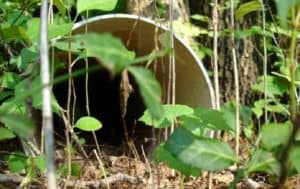
Photo Credit: Flickr Danielle Defrancesco
How it works: Voles will find the PVC pile while tunneling. They go into the pipes for shelter and food and eat the poison. They die in the pipes so they don’t endanger other animals.
This especially works during the winter when snow covers the ground because the pipe gives them protection and the bait provides food.
Purchase Commercial Voles Traps
Commercial vole traps are similar to mouse traps. You can also use mouse traps to get rid of voles.
First, inspect the tunnels to discover where they come out. Place the traps perpendicular to their tunnels.
Commercial traps will usually kill voles when they are set. You can dispose of the vole and rebate a new trap. You could reuse the trap, but be careful to clean it up first to avoid spreading disease.
You will need to place 12-24 traps in an average 1/8th of an acre yard. You will also need to check them regularly and replace them.
Glue traps are NOT recommended for vole use. They can capture other animals and wildlife. They also provide a longer, more painful death. Plus, they are less effective. Voles can shed, urinate and eventually escape from the trap.
Do not relocate voles to another area. That’s just inconsiderate of the people in the area where you release them. Even if it’s in a rural area, you are releasing the voles into a foreign spot and are more likely to attract bigger animals to rural homes that aren’t wanted.
Use Poison To Get Rid Of Voles
Poison is another low-effort way to get rid of voles. The biggest problem with poison is the risk of poisoning other animals. Bait voles in their tunnels.
Do not use the types of baits that make voles claustrophobic. This will cause them to leave their tunnels and make it more likely that another predator will eat the voles.
There are few poisons that are approved for vole use. DOn’t use poisons that aren’t specifically approved for use with voles. Many mouse poisons pose other dangers when used on voles.
Cost: Low cost for bait and most traps. Live traps are more expensive, especially considering the sheer volume of traps needed to contain voles.
Time Spent: Moderate time spent baiting and rebooting the traps.
Effectiveness: Highly effective
Permanence: Effective at least for the season.
Home Remedies Used Against Voles
There are numerous home remedies that have been used against voles. Some of them can be effective, especially in the short term. But, many of them are time consuming, and difficult to implement during some seasons, such as monsoon or winter.
I’ve included the most popular home remedies below:
- Caster Oil: Voles don’t like the smell of caster oil. It’s pungent and can fill up their tunnels quickly.
- Caspin: Hot and spicy peppers causes stinking when eaten. Mix caspin with water and spray on your plants and vegetation to help ward them off. This more likely to work when you have vole activity above the ground, but less likely to work if they are eating roots.
- Coyote or fox urine: Predator urine warns voles away. But, be aware, ammonia also creates an urge in males to reproduce. It’s a survival of the species. So, this remedy could backfire if you don’t use enough or surround your area with it. It must also be reapplied frequently.
Related Questions:
How Do I Protect My Lawn From Voles?
The best way to protect your lawn from the damage caused by voles is to either isolate it or trap the voles. If you choose to isolate it, use barriers that are at least 12 inches deep to keep voles from entering the lawn area. Trapping and poison are only effective when numerous traps are consistently set and maintained. Voles reproduce every few weeks and can quickly repopulate. Poison limits the population growth of the colony, while trapping requires you to continue to discard vole remains.
How Do I Protect My Garden From Voles?
Gardens are best protected from voles with a small barrier. It should be at least 6 inches high as voles cannot climb well. It should also be buried at least 12 inches deep. Hardware cloth, iron barriers, or other barriers can be used to keep them from coming into the garden. Use the barriers to keep voles from your produce and your plants safe. Trapping and poison usually don’t work well for the garden because of the risk of contamination to the plants.


